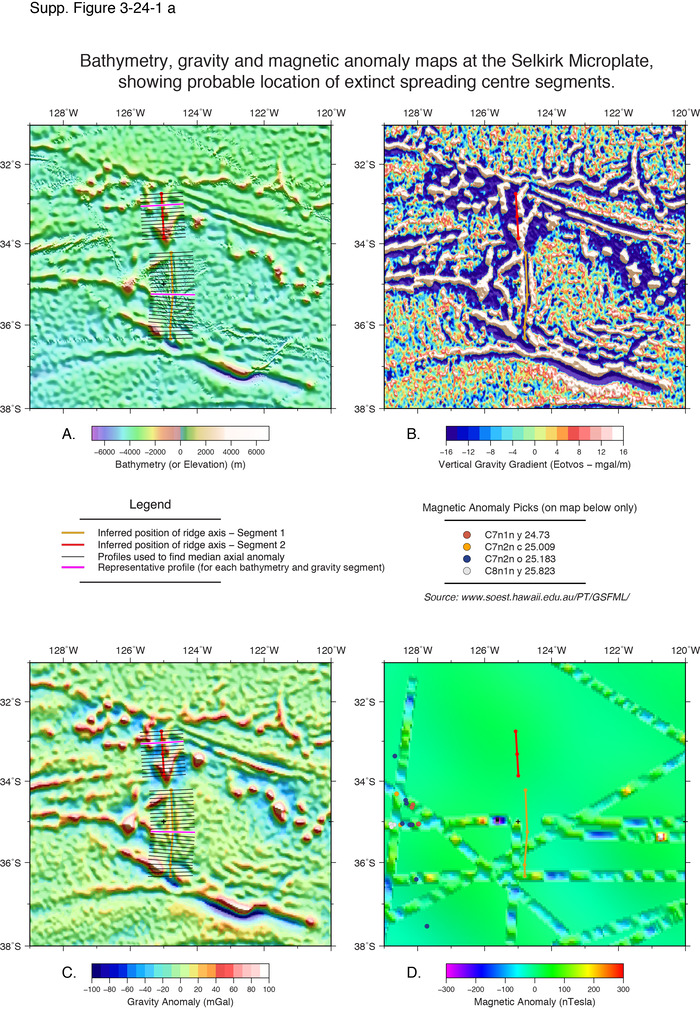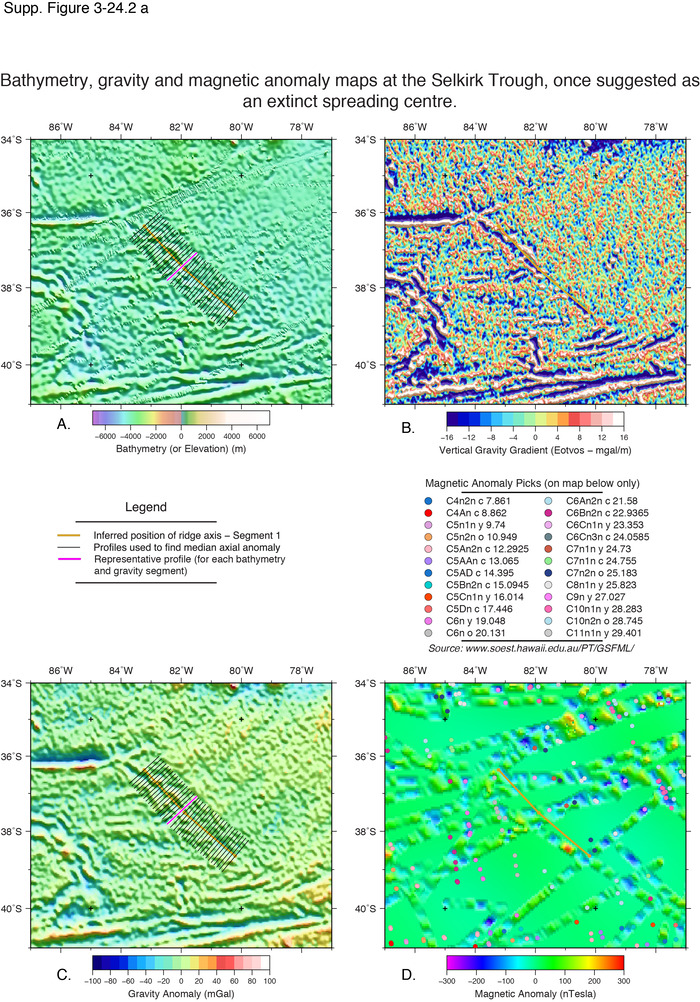| Ocean: | Pacific |
| Spreading center type: | Microplate spreading center |
| Time of cessation: | 20.8 Ma, chron C6A.r (Blais et al., 2002) or alternatively 17.5 Ma (Mammerickx, 1992) |
| Subsequent active spreading centre: | Reorganized East Pacific Rise (EPR) |
| Cessation style: | Relatively abrupt |
| Later deformation or volcanism: | None evident |
Two oceanic features have been given the name “Selkirk” and proposed as extinct spreading centres. The most convincing of these is the Selkirk microplate, proposed by Blais et al. (2002), using detailed swath bathymetry and magnetic data to constrain the microplates evolution. Another linear gravity feature, the Selkirk Trough, which is situated offshore South America has also been suggested as a possible extinct ridge axis (Okal and Bergeal, 1983), however the morphology of this structure has more in common with a pseudofault.
The Selkirk microplate was identified by Mammerickx (1992), who inferred a failed rift at approximately 125° W between the Resolution and Mocha fracture zones that are situated to the north and south of the microplate, respectively. Mammerickx (1992), suggested that the ridge had likely been formed by spreading between the Nazca and Pacific plates prior to a plate reorganization. The failed rift is identified as a deep and narrow trough with elevated flanking ridges (Mammerickx 1992, figure 5, p. 302) and the structure is suggested to have formed at 17.5 Ma. The Selkirk microplate has been argued to have formed in a similar way to the present-day microplates, such as the Easter and Juan Fernadez microplates (Searle et al., 1993).
Blais et al. (2002), argue that the Selkirk microplate rotated by duel spreading by a northward propagator on the Nazca flank of the Pacific-Nazca plate boundary at 24 Ma, causing clockwise rotation and a second spreading centre on the western boundary, before being dissected by the Pacific-Nazca-Antarctic triple junction propagator, that led to an eastward migration of the active spreading centre (Blais et al., 2002). The Selkirk trough is thought to be a pseudofault that marks the easternmost boundary of the northward propagator on the eastern Nazca flank (see Blais et al., 2002, figure 7). Hekinian et al. (1999) argue that a hotspot was located in close proximity to the Pacific-Nazca plate boundary at the time of the Selkirk Microplate development and rotation and that this greatly contributed to the migration of the plate boundary.
The Selkirk Trough had been suggested as a possible former spreading centre in an early study (Okal and Bergeal, 1983), yet later works have generally regard the structure as a pseudofault, generated by either propagation of the Pacific-Farallon (Nazca) plate boundary (Tebbens and Cande, 1997), or the Pacific-Nazca-Antarctic triple-junction at the Challenger FZ (Blais et al., 2002).
It is argued that the cessation of the Selkirk spreading centre occurred after a subtle change in rotation of the microplate, that led to compression along transform faults and “locking” of the microplate, with the crust becoming fixed to the Pacific plate, before a new spreading centre developed to the east (Blais et al., 2002). A result of this reconfiguration was a lengthier, consistently aligned plate boundary between Pacific and Nazca plates that removed significant offset that had developed at the Challenger-Resolution transform fault (Blais et al., 2002). The reconstruction of Blais et al. (2002) is not directly compatible with the earlier interpretation of Tebbens and Cande (1997) on which it is based, as the older study features a later age for the major reorganization of the triple junction plate boundary and multiple phases of spreading reconfiguration. From the varying trends of the tectonic fabric present across the region, it is likely that more than one reorganization took place and that the models represent the consecutive eastward migration of the Nazca-Pacific boundary over two northward propagations of the Antarctic plate boundary.






Blais, A., Gente, P., Maia, M., and Naar, D.F., 2002, A history of the Selkirk paleomicroplate, Tectonophysics, v. 359, no. 1-2, p. 157–169.
Mammerickx, J., 1992, The Foundation Seamounts: tectonic setting of a newly discovered seamount chain in the South Pacific, Earth and Planetary Science Letters, v. 113, p. 293–306.
Okal, E. a. and Bergeal, J.-M., 1983, Mapping the Miocene Farallon Ridge jump on the Pacific plate: a seismic line of weakness, Earth and Planetary Science Letters, v. 63, no. 1, p. 113–122.
Searle, R.C. et al., 1993, The development of two oceanic microplates: Easter and Juan Fernandez microplates, East Pacific Rise, Journal of the Geological Society, v. 150, no. 5, p. 965–976.
Tebbens, S. F., and Cande, S. C., 1997, Southeast Pacific tectonic evolution from early Oligocene to Present, Journal of Geophysical Research, v. 102, no. B6, p. 12,061 - 12, 084.